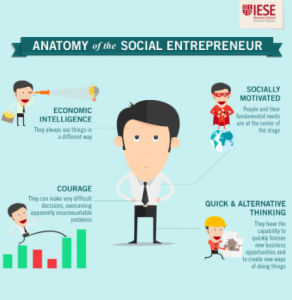Social Innovation
Social Innovation, a pillar of interest and importance
So what is it?
The goal of social entrepreneurship is to solve problems that traditional entrepreneurship has caused. Social entrepreneurship education is a blend of traditional entrepreneurship education, which combines traditional business goals (Kourilsky & Walstad, 2007), an entrepreneurship mindset, blended with modalities of empathy, leadership, and justice. Concepts around social entrepreneurship are emerging in mainstream society and need to be understood as having dissimilar goals to traditional entrepreneurship. In the book How to Change the World, Social Entrepreneurs and the Power of New Ideas (2007), author David Bornstein quotes Bill Drayton, the founder of Ashoka1 describes social entrepreneurs as, “agents of social change, whom, through entrepreneurial behavior, create solutions to social problems.” Ultimately, motivated by “altruism rather than profit…such individuals combine social goals with a business mindset to address largely unsatisfied needs in their communities” (Ghalwash, Tolba, & Ismail, 2017). The
The Stanford Business review summarizes the similarities between social entrepreneurship and traditional entrepreneurship: “much like its parent field of entrepreneurship, social entrepreneurship focuses on the personal qualities of people who start new organizations, and it celebrates traits like boldness, accountability, resourcefulness, ambition, persistence, and unreasonableness (Phills, 2008). There is one big difference; social entrepreneurs aim to solve long-standing social needs in their communities, while traditional entrepreneurs aim to make technological advancements (Weaver, 2016). I think this quote really captures the differences between social innovation and traditional entrepreneurship: It is “to do business differently by overcoming some of the deficiencies of conventional capitalist businesses that have led to the current crisis, and which may lead to future crises” (Lautermann, 2012), in relationship to overconsumption and environmental degradation

Anatomy of the Social Entrepreneur
Social innovation education is not limited to developing future entrepreneurs, it is about exploring the messiness of connections. Westley, Zimmerman, and Patton (2007), in their book Getting to Maybe: How the World Is Changed, describe social innovation through the lens of complexity theory. The authors explain that “getting to maybe” is a vision for change, situated within social innovation, bringing an intention to social change in our complex world, without any guarantees.
REFERENCES
Bornstein, D. (2007). How to Change the World: Social Entrepreneurs and the Power of New Ideas (Updat ed.). Oxford;Toronto; Oxford University Press
Ghalwash, S., Tolba, A., & Ismail, A. (2017). What motivates social entrepreneurs to start social ventures?: An exploratory study in the context of a developing economy. Social Enterprise Journal, 13(3), 268.
Kourilsky, M. L., Walstad, W. B., & Thomas, A. (2007). The entrepreneur in youth: An untapped resource for economic growth, social entrepreneurship, and education. Cheltenham, UK;Northampton, MA;: Edward Elgar.
Lautermann, C. (2012). Social Entrepreneurship: ProspActive Responsibility for a Better Society. In Social Responsibility, Entrepreneurship and the Common Good, International and Interdisciplinary Perspectives(pp. 1-313). Houndmills, Hampshire: Macmillan Limited. doi:10.1057/9780230354890
Phills, J.A., Jr, Deiglmeier, K. and Dale, M.T. (2008), “Rediscovering social innovation”, Stanford Social Innovation Review, Vol. 6 No. 4, pp. 34-43.
Weaver, R. L. (2016). Social enterprise self-employment programs: A two-dimensional human capital investment strategy. Social Enterprise Journal, 12(1), 4-20. 10.1108/SEJ-06-2015-0017